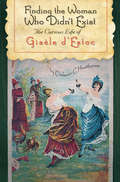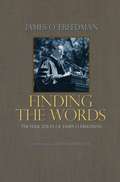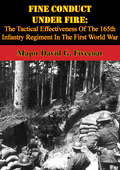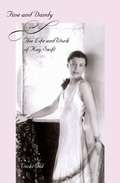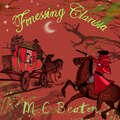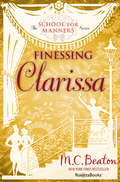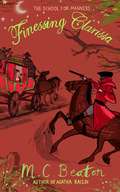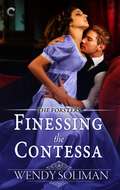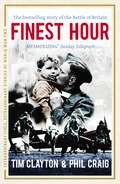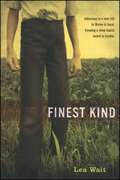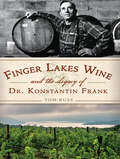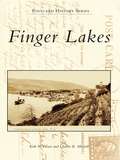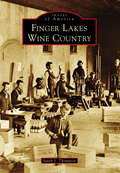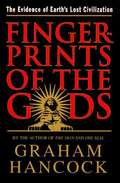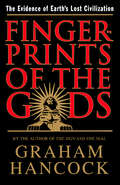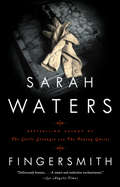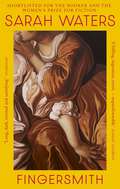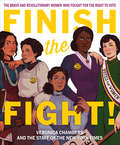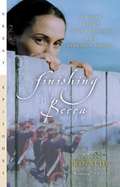- Table View
- List View
Finding the Limits of the Limes: Modelling Demography, Economy and Transport on the Edge of the Roman Empire (Computational Social Sciences)
by Philip Verhagen Jamie Joyce Mark R. GroenhuijzenThis open access book demonstrates the application of simulation modelling and network analysis techniques in the field of Roman studies. It summarizes and discusses the results of a 5-year research project carried out by the editors that aimed to apply spatial dynamical modelling to reconstruct and understand the socio-economic development of the Dutch part of the Roman frontier (limes) zone, in particular the agrarian economy and the related development of settlement patterns and transport networks in the area. The project papers are accompanied by invited chapters presenting case studies and reflections from other parts of the Roman Empire focusing on the themes of subsistence economy, demography, transport and mobility, and socio-economic networks in the Roman period.The book shows the added value of state-of-the-art computer modelling techniques and bridges computational and conventional approaches. Topics that will be of particular interest to archaeologists are the question of (forced) surplus production, the demographic and economic effects of the Roman occupation on the local population, and the structuring of transport networks and settlement patterns. For modellers, issues of sensitivity analysis and validation of modelling results are specifically addressed. This book will appeal to students and researchers working in the computational humanities and social sciences, in particular, archaeology and ancient history.
Finding the Movement: Sexuality, Contested Space, and Feminist Activism
by Anne EnkeIn Finding the Movement, Anne Enke reveals that diverse women's engagement with public spaces gave rise to and profoundly shaped second-wave feminism. Focusing on women's activism in Detroit, Chicago, and Minneapolis-St. Paul during the 1960s and 1970s, Enke describes how women across race and class created a massive groundswell of feminist activism by directly intervening in the urban landscape. They secured illicit meeting spaces and gained access to public athletic fields. They fought to open bars to women and abolish gendered dress codes and prohibitions against lesbian congregation. They created alternative spaces, such as coffeehouses, where women could socialize and organize. They opened women-oriented bookstores, restaurants, cafes, and clubs, and they took it upon themselves to establish women's shelters, health clinics, and credit unions in order to support women's bodily autonomy. By considering the development of feminism through an analysis of public space, Enke expands and revises the historiography of second-wave feminism. She suggests that the movement was so widespread because it was built by people who did not identify themselves as feminists as well as by those who did. Her focus on claims to public space helps to explain why sexuality, lesbianism, and gender expression were so central to feminist activism. Her spatial analysis also sheds light on hierarchies within the movement. As women turned commercial, civic, and institutional spaces into sites of activism, they produced, as well as resisted, exclusionary dynamics.
Finding the Woman Who Didn't Exist: The Curious Life of Gisèle d'Estoc
by Melanie C. HawthorneGisèle d&’Estoc was the pseudonym of a nineteenth-century French woman writer and, it turns out, artist who, among other things, was accused of being a bomb-planting anarchist, the cross-dressing lover of writer Guy de Maupassant, and the fighter of at least one duel with another woman, inspiring Bayard&’s famous painting on the subject. The true identity of this enigmatic woman remained unknown and was even considered fictional until recently, when Melanie C. Hawthorne resurrected d&’Estoc&’s discarded story from the annals of forgotten history.Finding the Woman Who Didn&’t Exist begins with the claim by expert literary historians of France on the eve of World War II that the woman then known only as Gisèle d&’Estoc was merely a hoax. More than fifty years later, Hawthorne not only proves that she did exist but also uncovers details about her fascinating life and career, along the way adding to our understanding of nineteenth-century France, literary culture, and gender identity. Hawthorne explores the intriguing life of the real d&’Estoc, explaining why others came to doubt the &“experts&” and following the threads of evidence that the latter overlooked. In focusing on how narratives are shaped for particular audiences at particular times, Hawthorne also tells &“the story of the story,&” which reveals how the habits of thought fostered by the humanities continue to matter beyond the halls of academe.
Finding the Words: The Education of James O. Freedman
by James O. FreedmanJames Freedman, the fifteenth president of Dartmouth College, began life in a struggling middle-class Jewish family in a provincial industrial New Hampshire town. By the time of his death from cancer in March 2006, he was one of the most celebrated educational leaders of his generation, perhaps of the twentieth century. Finding the Words is Freedman's account of the first twenty-seven years of this astonishing trajectory in a life made difficult by depression, but sustained throughout by a love of books and learning, a life that would transform the culture of American higher education. His mother's fierce and bruising ambition instilled in him an overwhelming drive to leave his mark upon the world. His father, a revered high-school English teacher who was timid outside the classroom, introduced him to the rich world of literature--and also passed on to him his doubts and insecurities. Freedman retraces his intellectual formation as a student, educator, scholar, and leader, from his early?obsession with book collecting through his undergraduate years at Harvard and his professional training at Yale Law School. This same passion for language and ideas defined Freedman's leadership at Dartmouth, where he deftly countered lingering anti-Semitism, fought entrenched interests to open the way for women and minorities, reformed and revitalized the curriculum, and boldly reconceived the school's campus. This moving and inspiring book vividly depicts the formative years of a man nourished by lifelong learning, whose rise from humble beginnings to heights of achievement will serve as a model for generations to come.
Fine Conduct Under Fire: The Tactical Effectiveness Of The 165th Infantry Regiment In The First World War
by Major David G. FivecoatRecent historiography has almost universally denounced the tactical prowess of the American Expeditionary Force. However, a detailed analysis of the performance of the 42nd Division's 165th Infantry Regiment tells a surprisingly different story. Despite the challenges of the First World War battlefield, the 165th Infantry Regiment compiled a remarkable record of tactical effectiveness in its 180 days of combat. During its six campaigns, the regiment repeatedly held the line and seized objectives against veteran German units in a variety of situations and under various conditions. At the regimental level, a de facto adoption of trench warfare doctrine enabled the unit to synchronize the combined arms and avoid the doctrinal dysfunction the plagued the majority of the AEF. At the tactical level, the Irish platoons and companies rapidly became adept at using Indian-style or infiltration tactics to advance, seize terrain, and destroy German positions. In addition, superb leadership throughout the regiment and stellar unit cohesion played significant roles in the unit's superior tactical proficiency. In sum, these four factors enabled the 165th to achieve a level of tactical effectiveness second to none among the non-regular regiments of the AEF and equal to the best units within the German Army.
Fine Print: A Story about Johann Gutenberg
by Joann Johansen BurchRecounts the story of the German printer credited with the invention of printing with movable type.
Fine and Dandy: The Life and Work of Kay Swift
by Vicki OhlKay Swift (1897-1993) was one of the few women composers active on Broadway in the first half of the twentieth century. Best known as George Gershwin's assistant, musical adviser, and intimate friend, Swift was in fact an accomplished musician herself, a pianist and composer whose Fine and Dandy (1930) was the first complete Broadway musical written by a woman. This book - the first biography of Swift - discusses her music and her extraordinary life. Vicki Ohl describes Swift's work for musical theater, the ballet, Radio City Music Hall's Rockettes, and commercial shows. She also tells how Swift served as director of light music for the 1939 World's Fair, eloped with a cowboy from the rodeo at the fair, and abandoned her native New York for Oregon, later fashioning her experiences into an autobiographical novel, Who Could Ask for Anything More? Informed by material, including Swift's unpublished memoirs and extensive interviews with her family members and friends, this book captures the essence and spirit of a remarkable woman. --BOOK JACKET. Title Summary field provided by Blackwell North America, Inc. All Rights Reserved
Finessing Clarissa (School for Manners #4)
by M.C. Beaton'If you have a Wild, Unruly, or Undisciplined Daugher, two Ladies of Genteel Birth offer to Bring Out said Daughter and Refine what may have seemed Unrefinable. We can make the Best of the Worst'When Amy and Effie Tribble, two charming but impoverished spinster sisters, lose out on an inheritance, they place this advertisement in The Morning Post and hire themselves out as professional chaperones. Vowing to prepare even the most difficult misses for marriage, the Tribble sisters will spend a London season on each client, educating them in their School for Manners.Lovely, wealthy and well bred, Clarissa Vevian has been unable to find a suitable husband because of her terrible clumsiness. Her petite and fastidious mother has tried to mould Clarissa into a dainty miss to fit the fashion - but all her efforts are doomed to failure. And when Clarissa enters the Tribble sister's home, they fear that their reputation for matchmaking success may be destroyed - along with their carpets and furniture!
Finessing Clarissa (The School for Manners Series #4)
by M. C. BeatonIn this Regency romance by the New York Times–bestselling author of the Agatha Raisin mysteries, an awkward redhead needs help finding love.In the fourth volume in the School for Manners series, we meet another of the young ladies deemed unsuitable for marriage due to some awkward attribute. This time it is the remarkably clumsy Clarissa Vevian, whose Junoesque proportions and flame-colored hair make her a daunting prospect for marriage-minded dandies. Dispatched to London by her despairing family, she is taken in hand by the redoubtable Tribble sisters, Amy and Effie, who tutor, groom and pummel her into shape for an accident-ridden debut. When the Earl of Greystone, a most eligible bachelor, Clarissa will certainly leave an impression… ABOUT THE SERIES The Misses Tribble, Amy and Effie, spinster sisters of a certain age, have lived for years on expectations of a great inheritance. When this fails to materialize, they are truly destitute. Desperate, they advertise that they will refine wild and unruly daughters, present them, and see them safely wed. The School for Manners six book series follows these two stalwart spinsters as they undertake enterprises of matchmaking and navigate the troublesome machinations of the London marriage mart.&“With customary grace, Chesney charms with this latest Regency froth.&”—Publishers Weekly
Finessing Clarissa: A Novel Of Regency England - Being The Fourth Volume Of The School For Manners (School for Manners #4)
by M.C. Beaton'If you have a Wild, Unruly, or Undisciplined Daugher, two Ladies of Genteel Birth offer to Bring Out said Daughter and Refine what may have seemed Unrefinable. We can make the Best of the Worst'When Amy and Effie Tribble, two charming but impoverished spinster sisters, lose out on an inheritance, they place this advertisement in The Morning Post and hire themselves out as professional chaperones. Vowing to prepare even the most difficult misses for marriage, the Tribble sisters will spend a London season on each client, educating them in their School for Manners.Lovely, wealthy and well bred, Clarissa Vevian has been unable to find a suitable husband because of her terrible clumsiness. Her petite and fastidious mother has tried to mould Clarissa into a dainty miss to fit the fashion - but all her efforts are doomed to failure. And when Clarissa enters the Tribble sister's home, they fear that their reputation for matchmaking success may be destroyed - along with their carpets and furniture!
Finessing the Contessa
by Wendy SolimanBook three of The ForstersEngland, 1815Lord Robert Forster hopes to meet his match-on the chessboard. He jumps at the chance to cross rooks with the renowned Sicilian widow Contessa Electra Falzone. However, the lovely foreigner's bold opening gambit raises concerns about her politics when she finds her way into his bedchamber, not with seduction in mind, but to steal state secrets.Electra Falzone has always avoided scandalous liaisons, until blackmail forces her to turn thief and risk her reputation in the arms of the handsome Lord Robert. If her manipulators were threatening only her, she would confess all to her fellow strategist. But given who will suffer if she fails, she can't afford to take that risk.Drawn to the exotic contessa, Rob won't allow her to be used as a pawn by an unscrupulous schemer. But if Electra is determined to play this dangerous game for reasons of her own, nothing Rob can do will stop her.Meet Rob's siblings in Compromising the Marquess and Beguiling the Barrister.76,000 words
Finest Hour: The bestselling story of the Battle of Britain (Extraordinary Lives, Extraordinary Stories of World War Two #3)
by Phil Craig Tim ClaytonSeventy years ago, Europe lay at Hitler's feet. Britain faced its darkest hour - outnumbered and friendless as the German army continued its advance. Defeat or capitulation seemed inevitable. But instead a legend was born. Taking its readers on a breathtaking journey from open lifeboats in Atlantic gales to the cockpits of burning fighter-planes, and through cities devastated by the Blitz, FINEST HOUR recreates the terror, the tragedy and the triumph of the Battle of Britain. This powerful account of the events of 1940 is told through the voices, diaries, letters and memoirs of the men and women who lived, loved, fought and died during this terrible yet inspiring year. FINEST HOUR blends original historical research with the experiences of ordinary people in desperate times. Cutting through the nostalgic haze, this book enables readers to experience a time - still within living memory - when a nations's darkest hour became its finest.
Finest Kind
by Lea WaitWHAT CAN YOU DO WHEN YOU'RE TWELVE YEARS OLD AND YOUR WORLD IS FALLING APART? It's 1838. Jake's father has lost his job and his savings. Hearing of work in Maine, the family leaves their large home in Boston and heads north, taking with them a few furnishings—and a deep family secret. In Maine they find only a dirty, isolated farmhouse, and a job for Father that takes him away from home. "I'll have to depend on you," Jake's mother tells him. But how can Jake find food? How can he prepare for the dangerous cold of a Maine winter? How can he protect his mother—and his family's secret? Slowly, Jake learns the ways to survive, catching game and storing food for the long winter months. Nabby McCord, whose family also has a secret, helps him. So does Granny McPherson, who may be a witch. But when it comes to earning the money they need, Jake knows he's on his own. He shows his determination as the winter approaches, but does he have what it takes to bring his family together to face the future—and their past? Finest Kind is the powerful story of a boy who is forced to become a man and to learn the truth about courage, friendship, and secrets.
Finger Lake Wine and the Legacy of Dr. Konstantin Frank (American Palate)
by Tom RussThe remarkable story of a refugee from Soviet Ukraine who found his way to upstate New York—and changed the American wine industry. Dr. Konstantin Frank forever changed the palate of American wine. Forced from his home in Soviet Ukraine during World War II, he was astounded by the terroir when he arrived in the Finger Lakes region, an agricultural scientist from a foreign land desperately looking for work. Against popular notions, he believed that the vinifera grapes that produced some of Europe&’s and California&’s finest wines would prosper in this part of New York State, but was met with skepticism and resistance. He proved his detractors wrong, and because he shared his knowledge freely with others, Konstantin&’s innovativeness has allowed the region to produce some of the world&’s finest Riesling, Chardonnay, Pinot Noir, and other varietals. Four generations of Franks have continued his legacy, and their winery has won record numbers of prestigious awards every year. This book tells the inspiring story. Includes photographs
Finger Lakes
by Kirk W. House Charles R. MitchellFor more than a century, the natural scenic beauty of the Finger Lakes has drawn generations of tourists. The vineyards, glens, and steamers that made the region famous are displayed through the vintage images in this volume. These postcards capture the lively and dynamic atmosphere that has kept visitors flocking to the area for years, eager to mail a piece of their memories back home.
Finger Lakes Wine Country (Images of America)
by Sarah ThompsonFor more than 150 years, Finger Lakes Wine Country has played a major role in American wine history. At its heart are the four deepest Finger Lakes, part of a group of 11 long, narrow lakes in central New York. There, nestled among Canandaigua, Keuka, Seneca, and Cayuga Lakes, farmers began planting vineyards in the 1830s. In 1860, the Pleasant Valley Wine Company became America's first bonded winery, turning Keuka Lake into a busy shipping hub for fresh grapes and award-winning champagnes. Other wineries soon followed, as did railroads and basket factories. Early 20th century business was good until Prohibition forced wineries to reinvent themselves. In the 1950s and 1960s, innovators like Charles Fournier, Dr. Konstantin Frank, and Walter S. Taylor experimented with hybrid and European vinifera grape varieties. But by the 1970s, local grape growers faced extinction; it would take a grassroots movement and landmark legislation in 1976 to bring about a Finger Lakes wine renaissance.
Fingerprints of the Gods: The Evidence of Earth's Lost Civilization
by Graham HancockOn the great mysteries of nature, history, and man.
Fingerprints of the Gods: The Quest for Earth's Lost Civilization
by Graham HancockCould the story of mankind be far older than we have previously believed? Using tools as varied as archaeo-astronomy, geology, and computer analysis of ancient myths, Graham Hancock presents a compelling case to suggest that it is.Graham Hancock is featured in the popular Ancient Apocalypse, a Netflix original docuseries."Hancock structure his arguments through the scientific method. . . . He's asking the right questions. . . . If it's true, then it can significantly change the course of history and our understanding of our civilisations." —MediumIn Fingerprints of the Gods, Hancock embarks on a worldwide quest to put together all the pieces of the vast and fascinating jigsaw of mankind's hidden past. In ancient monuments as far apart as Egypt's Great Sphinx, the strange Andean ruins of Tiahuanaco, and Mexico's awe-inspiring Temples of the Sun and Moon, he reveals not only the clear fingerprints of an as-yet-unidentified civilization of remote antiquity, but also startling evidence of its vast sophistication, technological advancement, and evolved scientific knowledge.A record-breaking #1 bestseller in Britain, Fingerprints of the Gods contains the makings of an intellectual revolution, a dramatic and irreversible change in the way that we understand out past—and so our future.And Fingerprints of the Gods tells us something more. As we recover the truth about prehistory, and discover the real meaning of ancient myths and monuments, it becomes apparent that a warning has been handed down to us, a warning of terrible cataclysm that afflicts the Earth in great cycles at irregular intervals of time—a cataclysm that may be about to recur.
Fingersmith
by Sarah WatersA Penguin Book Club PickThe thrilling Dickensian novel from the bestselling author of The Little Stranger and The Paying Guests.Sue Trinder is an orphan, left as an infant in the care of Mrs. Sucksby, a "baby farmer," who raised her with unusual tenderness, as if Sue were her own. Mrs. Sucksby's household, with its fussy babies calmed with doses of gin, also hosts a transient family of petty thieves--fingersmiths--for whom this house in the heart of a mean London slum is home.One day, the most beloved thief of all arrives--Gentleman, an elegant con man, who carries with him an enticing proposition for Sue: If she wins a position as the maid to Maud Lilly, a naïve gentlewoman, and aids Gentleman in her seduction, then they will all share in Maud's vast inheritance. Once the inheritance is secured, Maud will be disposed of--passed off as mad, and made to live out the rest of her days in a lunatic asylum.With dreams of paying back the kindness of her adopted family, Sue agrees to the plan. Once in, however, Sue begins to pity her helpless mark and care for Maud Lilly in unexpected ways. . . . But no one and nothing is as it seems in this Dickensian novel of thrills and reversals.
Fingersmith: A BBC 2 Between the Covers Book Club Pick – Booker Prize Shortlisted
by Sarah WatersA BBC TWO BETWEEN THE COVERS BOOK CLUB PICK (BOOKER PRIZE GEMS)London 1862. Sue Trinder, orphaned at birth, grows up among petty thieves - fingersmiths - under the rough but loving care of Mrs Sucksby and her 'family'. But from the moment she draws breath, Sue's fate is linked to that of another orphan growing up in a gloomy mansion not too many miles away.
Fingersmith: shortlisted for the Booker Prize
by Sarah WatersThe book that inspired Park Chan-wook's astonishing film The Handmaiden.Shortlisted for the Orange Prize and the Booker PrizeLondon 1862. Sue Trinder, orphaned at birth, grows up among petty thieves - fingersmiths - under the rough but loving care of Mrs Sucksby and her 'family'. But from the moment she draws breath, Sue's fate is linked to that of another orphan growing up in a gloomy mansion not too many miles away.
Finish the Fight!: The Brave and Revolutionary Women Who Fought for the Right to Vote
by Veronica Chambers The Staff of The New York TimesWho was at the forefront of women's right to vote? We know a few famous names, like Susan B. Anthony and Elizabeth Cady Stanton, but what about so many others from diverse backgrounds—black, Asian, Latinx, Native American, and more—who helped lead the fight for suffrage? On the hundredth anniversary of the historic win for women's rights, it's time to celebrate the names and stories of the women whose stories have yet to be told. Gorgeous portraits accompany biographies of such fierce but forgotten women as Yankton Dakota Sioux writer and advocate Zitkála-Šá, Mary Eliza Church Terrell, who cofounded the National Association of Colored Women (NACW), and Mabel Ping-Hua Lee, who, at just sixteen years old, helped lead the biggest parade in history to promote the cause of suffrage. FINISH THE FIGHT will fit alongside important collections that tell the full story of America's fiercest women. Perfect for fans of GOOD NIGHT STORIES FOR REBEL GIRLS and BAD GIRLS THROUGHOUT HISTORY.
Finishing Becca: A Story about Peggy Shippen and Benedict Arnold
by Ann RinaldiA fourteen-year-old maid witnesses the events that lead to General Benedict Arnold's betrayal of the American forces during the Revolutionary War.
Finishing Becca: A Story about Peggy Shippen and Benedict Arnold (Great Episodes Ser.)
by Ann RinaldiAn independent-minded young maid tells the story of social-climber Peggy Shippen and how she influenced Benedict Arnold's betrayal of the Patriot forces. Revolutionary Philadelphia is brought to life as Becca seeks to find her "missing pieces" while exploring the complicated issues of the war between the impoverished independence men and the decadent British Tories. "This tale of treachery comes alive under [Rinaldi's] pen."--Kirkus Reviews
Finishing Business: Ten Steps to Defeat Global Terror
by Harlan K. UllmanUllman examines the underlying causes and political motivations that drive global terrorism. He analyzes the attraction that Jihadist Extremism holds for disaffected Muslims around the world and argues that American governance is currently not up to the task of keeping the nation safe. He then describes ten concrete steps America can take to defeat global terror. Ullman is a columnist for the Washington Times.


